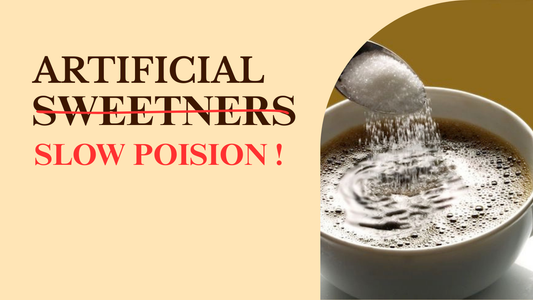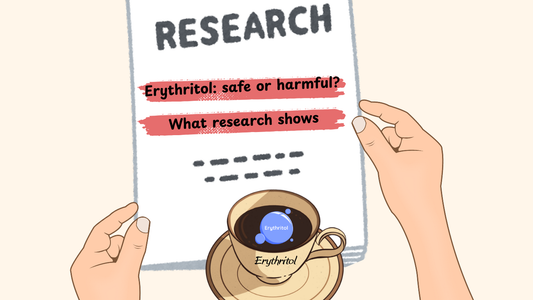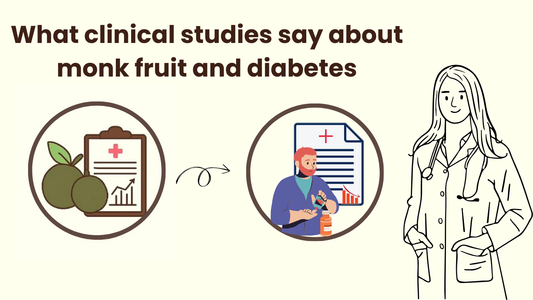Introduction: A World Looking for Sweetness Without Damage
Sugar is everywhere - in biscuits, juices, cereals, sauces. It fuels India’s diabetes crisis and the global obesity epidemic. People know sugar is a problem, but they still crave sweetness. That’s why the search for sugar alternatives has become one of the biggest frontiers in nutrition science.
👉 The question is: which sugar alternative will define the future?
Why Sugar Alternatives Matter Now
-
Global Diabetes Epidemic: Over 500 million people worldwide live with diabetes. India alone has 100 million diabetics.
-
Obesity Crisis: Added sugars are a key driver of weight gain and fatty liver disease.
-
Consumer Demand: People want sweetness but also want “clean labels,” natural products, and zero side effects.
This isn’t a wellness trend. It’s a survival need.
The First Wave: Artificial Sweeteners
The 20th century brought saccharin, aspartame, sucralose.
-
Pros: zero calories, intense sweetness.
-
Cons: trust issues, synthetic image, possible gut health effects.
-
Research: Regulatory bodies (FDA, EFSA) still consider them safe within limits. But public perception is negative.
👉 Artificial sweeteners may survive, but they won’t define the clean, natural future.
The Second Wave: Natural Alternatives
The last 20 years brought stevia, monk fruit, sugar alcohols (erythritol, xylitol).
Stevia
-
Extracted from stevia leaves.
-
Zero calories, 200-300x sweeter than sugar.
-
Issues: bitter aftertaste, highly processed extracts.
Sugar Alcohols (Erythritol, Xylitol)
-
Found naturally in fruits, produced by fermentation.
-
Low calorie, low glycemic impact.
-
Issues: bloating, digestive discomfort at high doses (except erythritol, which is well tolerated).
Monk Fruit (Luo Han Guo)
-
Sweetness from mogrosides, not sugar.
-
Zero glycemic index, safe for diabetics.
-
Natural, clean taste, increasingly popular.
👉 Monk fruit + erythritol blends (like EPRA’s) are seen as the gold standard for clean, usable sweetness.
The Third Wave: Functional Sweeteners
Future sugar alternatives won’t just be about zero calories. They’ll add health benefits.
-
Allulose: Rare sugar found in fruits, ~70% as sweet as sugar, but not metabolized → almost zero calories. Early research shows it may improve insulin sensitivity.
-
Tagatose: Rare sugar with prebiotic effects, supports gut health.
-
Novel plant extracts: Scientists are exploring sweetness from miracle fruit, brazzein protein (from berries), and other botanicals.
👉 Imagine sweeteners that don’t just avoid harm, but actively improve metabolism.
Health Research Trends to Watch
-
Gut Microbiome Impact
-
Artificial sweeteners like saccharin and sucralose may disrupt gut bacteria.
-
Monk fruit and erythritol show minimal impact.
-
Future research will focus heavily on how sweeteners affect gut health.
-
Metabolic Effects
-
Not all zero-calorie sweeteners are metabolically neutral.
-
Studies show allulose and monk fruit may even improve blood sugar control.
-
Expect more trials comparing sweeteners in diabetic and prediabetic populations.
-
Long-Term Safety
-
Artificial sweeteners have decades of safety data, but public trust is low.
-
Natural sweeteners will undergo long-term trials to prove they’re safe for daily use.
-
Brain & Cravings
-
Research is exploring whether non-sugar sweeteners still trigger cravings.
-
The future sweetener will need to taste like sugar without fueling sugar addiction.
The India Angle
India’s future in sugar alternatives is unique:
-
Huge diabetic population = urgent need.
-
Cultural trust in “natural” = advantage for monk fruit, stevia.
-
Rising awareness of gut health = opportunity for functional sweeteners.
👉 EPRA Farms has the chance to lead by introducing monk fruit and educating consumers - not just as a product, but as a movement.
The Challenges Ahead
-
Cost & Accessibility
-
Monk fruit is expensive to grow and extract.
-
Scaling production will be key to making it affordable for Indian households.
-
Consumer Education
-
Most Indians still believe jaggery, honey, or brown sugar are “healthy.”
-
Breaking these myths will take aggressive education.
-
Label Honesty
-
Many brands hide artificial sweeteners in “sugar-free” products.
-
The future belongs to brands that are clean, simple, transparent.
The Future of Sugar Alternatives
The future is clear:
-
Artificial sweeteners will survive, but mainly in diet sodas.
-
Natural sweeteners like monk fruit, stevia, erythritol will dominate mainstream use.
-
Functional sweeteners like allulose and tagatose will become the next revolution - sweetness that helps your body, not just avoids harm.
👉 And in India, monk fruit will be the pioneer of this change.
EPRA Farms’ Role in the Future
At EPRA Farms, we’re not waiting for the future. We’re building it.
-
Clean monk fruit blends → safe, natural sweetness for families.
-
Education → teaching India how to spot hidden sugars and fake health claims.
-
Transparency → no gimmicks, no half-truths, no hidden ingredients.
👉 Because the future of sugar alternatives isn’t just science. It’s trust.
FAQs
Q: Are artificial sweeteners unsafe?
Regulators say they’re safe, but many consumers distrust them. The future lies in natural options.
Q: Will monk fruit replace sugar everywhere?
It won’t replace every use, but it will be the go-to clean sweetener for diabetics, health-conscious families, and anyone avoiding hidden sugar.
Q: What about jaggery and honey?
They’re traditional but still sugar. They raise blood sugar and aren’t safe for diabetics.
Q: What’s the most exciting sweetener in research?
Allulose and tagatose - rare sugars that may actually improve metabolism.
Conclusion: Sweetness Without Sacrifice
The world is done with sugar. It’s done with fake health halos. The future belongs to sweeteners that are:
-
Natural.
-
Safe.
-
Clean.
-
Maybe even beneficial.
Artificial sweeteners were the first chapter. Natural sweeteners like monk fruit are the present. Functional sweeteners are the future.
👉 At EPRA Farms, we’re proud to be at the frontlines - giving India a clean, honest alternative right now.





